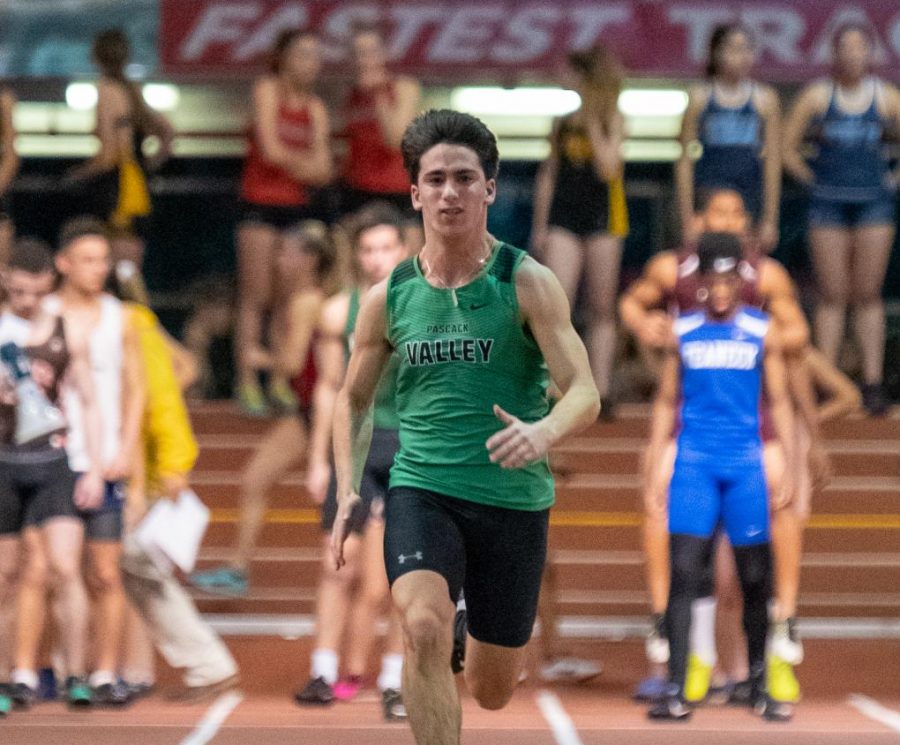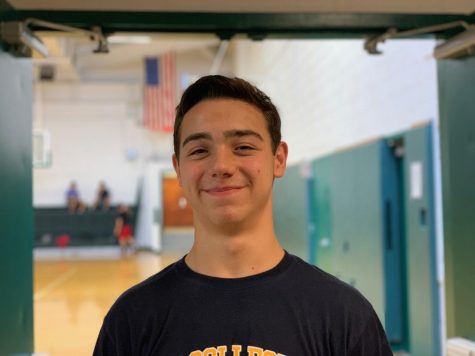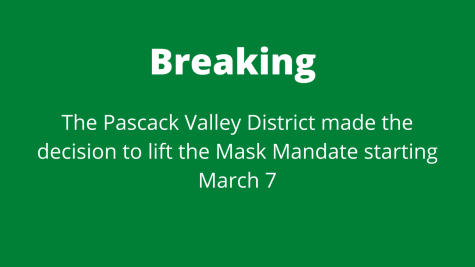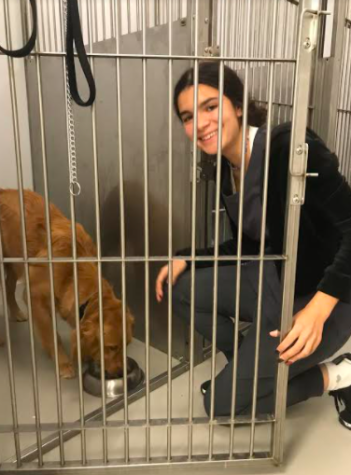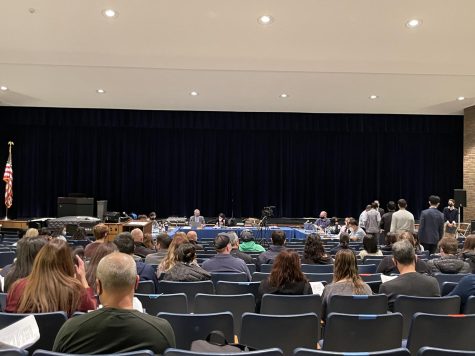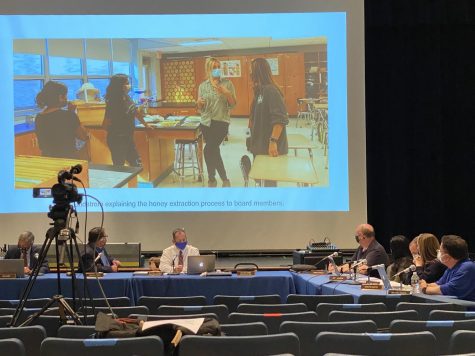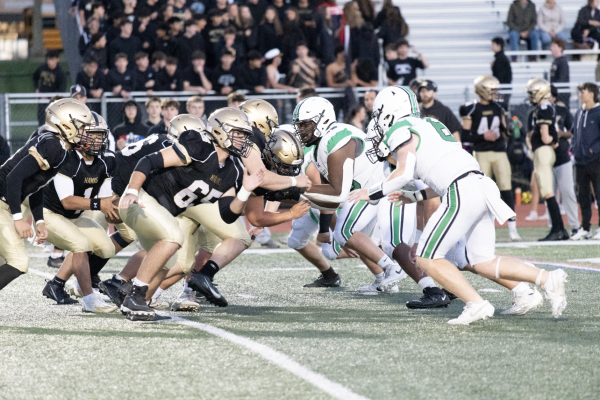The finish line for the winter track season
Pascack Valley’s Boys Sprint Medley Relay qualifies for nationals
Oren Roznitsky runs at the Armory Track in NYC. PV’s Sprint Medley Relay qualified for nationals before the event was cancelled due to coronavirus concerns.
In any sport, teams practice together countless times, in hopes that one day, they will have a chance to reach their dreams.
Pascack Valley’s nationals-bound Sprint Medley Relay (SMR) only had to run the race together for a total of… wait for it… one time.
That’s right. Once.
One chance was all the crew made up of Oren Roznitsky, Mike Supple, Eddie Mercurio, and Andrew Martinez needed to qualify for nationals.
The boys never had the opportunity to participate in nationals, since the New Balance Nationals were cancelled due to coronavirus concerns, but simply qualifying is a feat that few have accomplished.
3 minutes, 39.0 seconds was the required time to qualify for nationals; anything higher would not have done the job for the sprinters. The catch, however, is that the race had to be digitally-timed, meaning the foursome was unable to qualify at a dual meet.
“A lot of our meets are dual meets, where [the coaches] do hand-time, so the coaches would have to give us opportunities to go [to] professionally-timed meets,” Roznitsky said. “[Opportunities] won’t come very often, but just like this season, when they come, we would have to go out there and perform.”
These four only ran the SMR in two meets that were digitally-timed, meaning they only had two chances to qualify.
At the New Balance Games on Jan. 18 – in their first shot at qualifying – the boys punched their ticket to nationals, whilst also placing first, running 3:38.41.
With the 800-meter being the last leg of the relay at the New Balance Games, it was up to Martinez to clinch his and his teammates’ spots in nationals.
Congrats to @XcPvhs Mercurio, Roznitsky, Supple, + Martinez for winning the Sprint Medley Relay (3:38.41) at today’s @ArmoryNYC New Balance Games and for earning a spot at Nationals!! A remarkable day for Valley. #ValleyPride pic.twitter.com/ivarBm0ded
— Pascack Valley Athletics (@indianathletics) January 19, 2020
“When I got the baton at [around] 1:40, I was [thinking] ‘this is it, you gotta go,’” Martinez said. “After we qualified, it was just like all of our hard work just paid off all in one moment.”
“Our handoffs were good, We had pretty good chemistry, and I think we were ready for the moment,” Mercurio said.
After already qualifying, PV’s SMR ran again at the Bergen County Relays on Jan. 22; the time ran at the county relays would not have qualified for nationals, as the boys ran the relay in 3:41.51.
The Sprint Medley Relay is unlike any other race in track, as it involves four runners, sprinting three different distances, each passing the baton off to a teammate when finishing their respective race. In such an individualized sport, it is a refreshing change for the runners to take on a challenge with their teammates instead of by themselves.
“Track is a very individual sport, where you’re only timing yourself. Relays are the only chance you get to participate with your teammates,” Mercurio said. “There’s more accountability. You have three other guys counting on you, and you want to do your best for them.”
“It’s not like all of the pressure is on you, you’re just a piece of the puzzle and everyone else has to hold that up,” Roznitsky said.
In both times the group ran the relay this season, Mercurio started the races off running the 400, then Roznitsky and Supple followed, each running the 200, and Martinez capped off the relays, running the 800.
“The beautiful thing about this relay is that it is sprinting and distance combined,” Martinez said. “You get that comradery from both sides of track.”

As part of a group, each runner understands what his portion of the relay means for his teammates, and how his performance affects the rest of the relay.
“I understand that I am going to set the tone for this race,” Mercurio said. “I have full faith in the guys behind me that they are going to keep it up.”
“When I see [Mercurio] rounding the curve, coming towards me after the 400, [I’m thinking] ‘That-a-boy, you did your job. Now I’m going to take the baton and do my job,’” Roznitsky said.
As simple as track may seem, depending on the race, it can take some strategy to run the fastest time possible. In the SMR, with the participants running three different distances, and every second being all-too-important, strategy is crucial to determining if the group finishes with a time adequate to reach nationals, or if the group completely collapses and finishes in last place.
“The longer [distance] you run, the more strategic you have to be when you run, and when you want to exert the most energy” Mercurio said. “[Roznitsky] can just go [as hard as possible], and run as fast as he can for as long as he can.”
Despite only running the SMR twice this season, these athletes have run together for their entire track careers, even if it did not include them all participating in the same relay until now. With two chances at qualifying, the runners knew the importance of each race, and were ready for the opportunity to qualify for nationals.
“We still know each other, we still practice handoffs, and we still practice as a team,” Roznitsky said. “Just running the first time, with the adrenaline, the big atmosphere, going out for the first time on the big stage was really good for us, and that’s why we did so well.”
Valley’s SMR is made up of three seniors, with Supple being the odd man out as a junior. As the only non-senior in the relay, Supple had to earn his spot shortly before the foursome ran the relay for the first time.
“My spot was a little bit in jeopardy because we had three guys who could have been there,” Supple said.
Supple earned his spot by outrunning two of his teammates in the 200 earlier in the season, thus making him the fourth and final member of the SMR for Valley.
After it was decided which four runners would be taking part in the Sprint Medley Relay, the group knew what it was capable of, and even surpassed its own expectations.
“Doing the math in my head, I definitely saw us having potential,” Martinez said. “Personally, I thought my [portion of the relay] wasn’t going to be as fast as it was.”
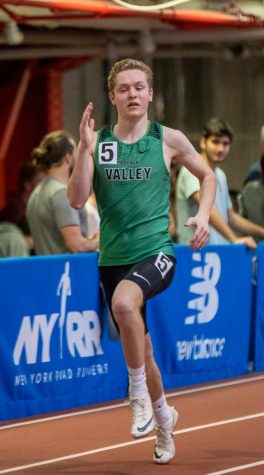
Eddie Mercurio runs the 400-meter.
By qualifying for nationals, the individuals participating in the SMR ensured their season would last much longer than the rest of the team. Those who qualified for nationals have continued practicing for weeks, while the rest of the team had time off in between the winter and spring seasons.
Without the rest of the team at practice everyday, those who qualified were able to focus more on their own workouts and improve in their individual events.
“When it was with a big group, we would do team practices,” Roznitsky said. “We do specific workouts that are tailored to each person.”
“With [coach Anthony Judilla] we’re doing different drills, because he can individually time us all, and tell us what we need to do to every rep,” Supple said.
Unfortunately, the more time spent on the track, the more opportunities there are for one of the four to get injured. Mercurio suffered a strained calf while training for nationals, and he has dealt with the mental and physical struggles of it since, while still bearing in mind the challenge that lies ahead.
“In terms of an injury, it’s a two to three week thing. It’s not going to kill me forever,” Mercurio said. “But I really did not run very well after getting back, and [the injury] was a mental hurdle to get over.”
The Sprint Medley Relay may not be a relay that is run extremely often, but another relay is part of almost every meet in both indoor and outdoor track: the 4×400 relay.
The 4×400 is much simpler than the SMR, as all four athletes each run the 400, one at a time, passing the baton off to their teammates after completing their portion.
The runners used their experience from the 4×400 to prepare themselves for the race itself, as well as the atmosphere. At most meets, it is the final race, with the participants getting to run when the lights shine brightest.
“You get to go out there with your teammates,” Mercurio said. “There’s just something different about it.”
“It’s the race,” Roznitsky said.
Qualifying for nationals is certainly an accomplishment, but just like anything else, it did not come without hard work.
The more glorious parts of track – the PRs (personal records), the medals, the big meets – are seen by everyone; the more grueling parts are untold.
“There are a lot of times when I could just easily slow down,” Supple said. “You have to remember to keep pushing through and it will all pay off.”
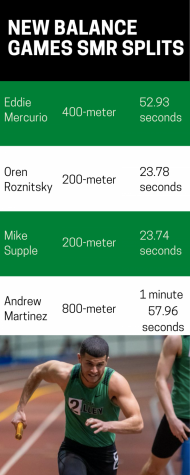
PRs are hard to come by, but when they do, it confirms that hard work is in fact paying off.
“[PRs are] very rare to come by,” Martinez said. “But it is one of the best feelings.”
Despite being the same sport, there is a noticeable difference between indoor and outdoor track for all four of the participants in Valley’s SMR. Running in both seasons of track, the group knows the advantages and disadvantages of both.
Of course, in outdoor track, the length of the track is 400 meters, as opposed to 200-meters indoors. With less turns on the outdoor track, runners’ best times generally come during the spring season. However, that is just the beginning of the differences between the two.
“I like winter meets better. They’re indoors, so you’re warm. It’s not like the wind is blowing anywhere,” Supple said. “There are a lot more teams running there, because [the meets] are all invitationals.”
“A lot more people come out for spring track. There is higher competition, especially at the higher level,” Roznitsky said. “People who are doing other sports like basketball or wrestling in the winter, now come out for spring track.”
“There are a lot more outdoor tracks as opposed to indoor tracks, so there are more opportunities to compete,” Mercurio said.
Although nationals is the end of the indoor track season, the foursome look to continue to improve, as they will all be participating in outdoor track this spring.
“It’s gonna be nice to see what we can do,” Mercurio said. “[We’ll] see if we can go back to nationals for the outdoor season.”
“Given that times will be faster and we are still improving, [nationals] is definitely still a goal for us,” Roznitsky said.


